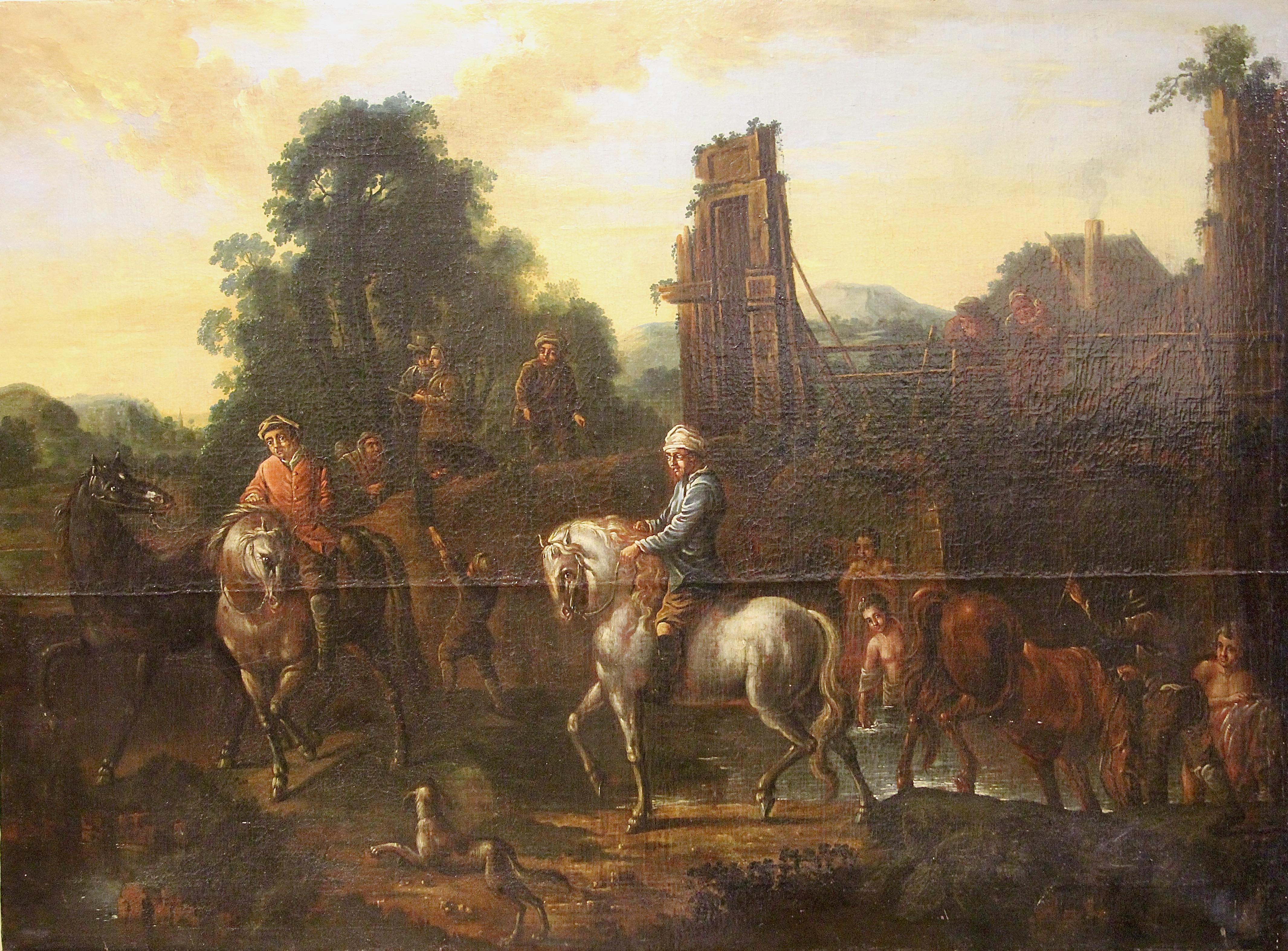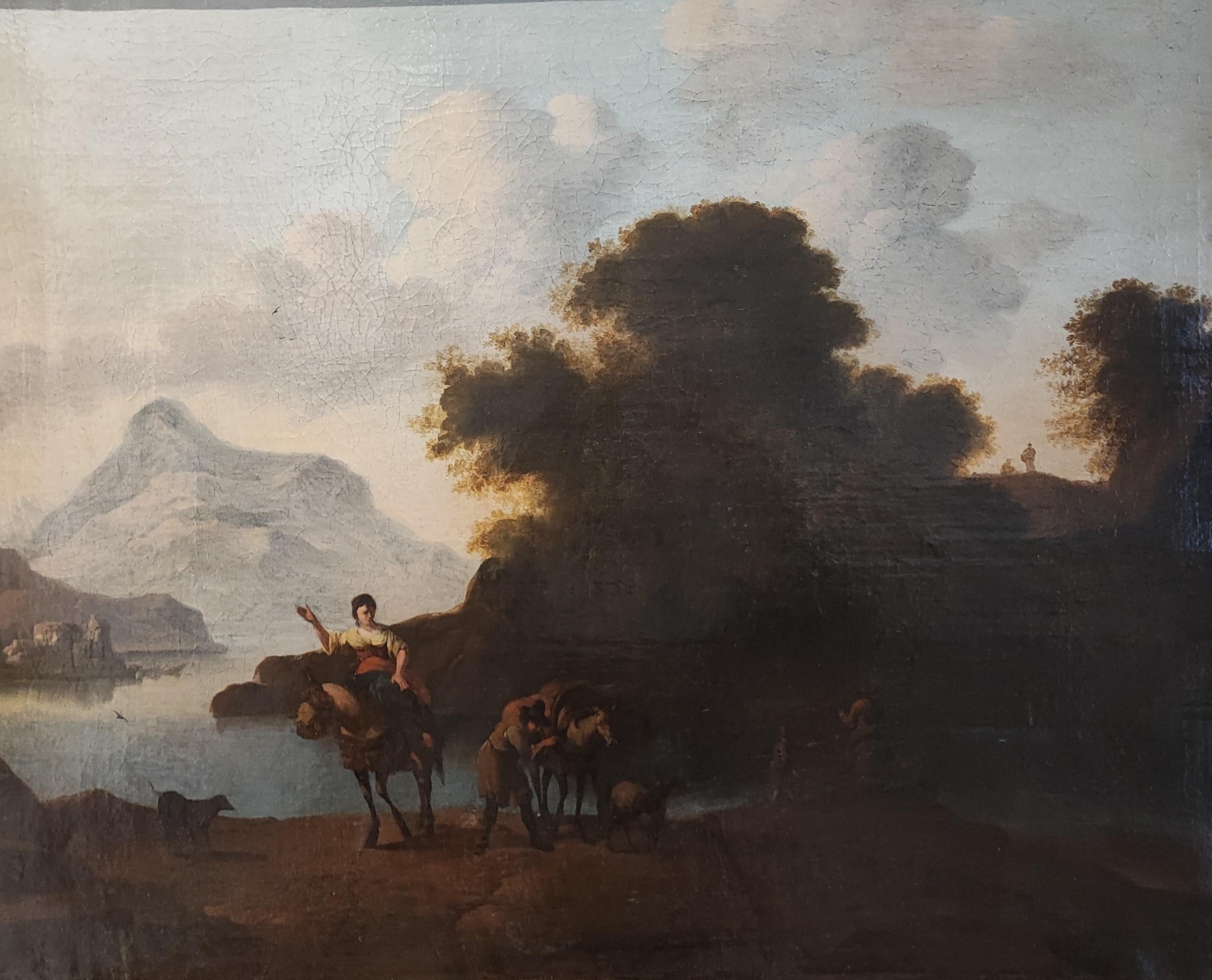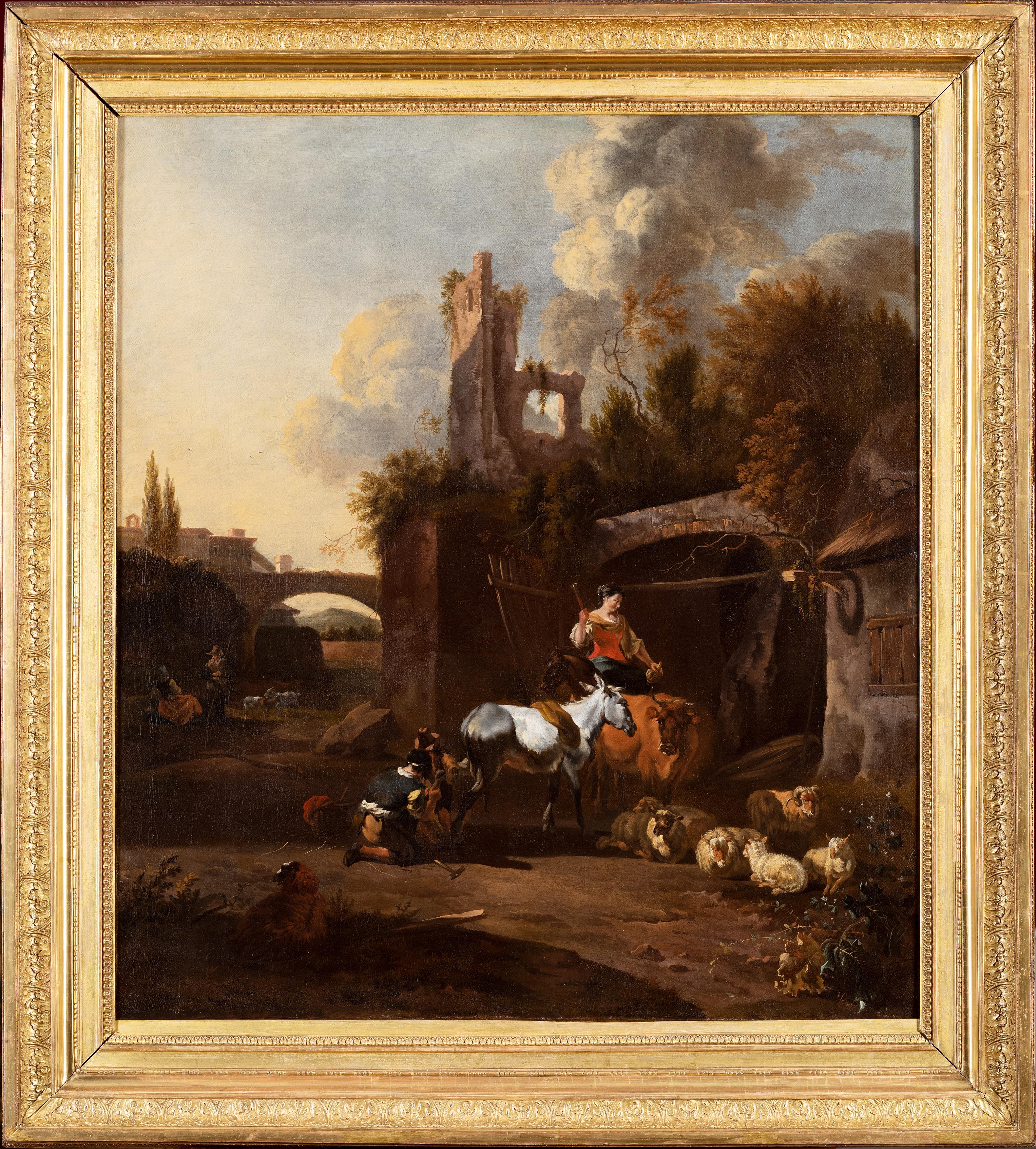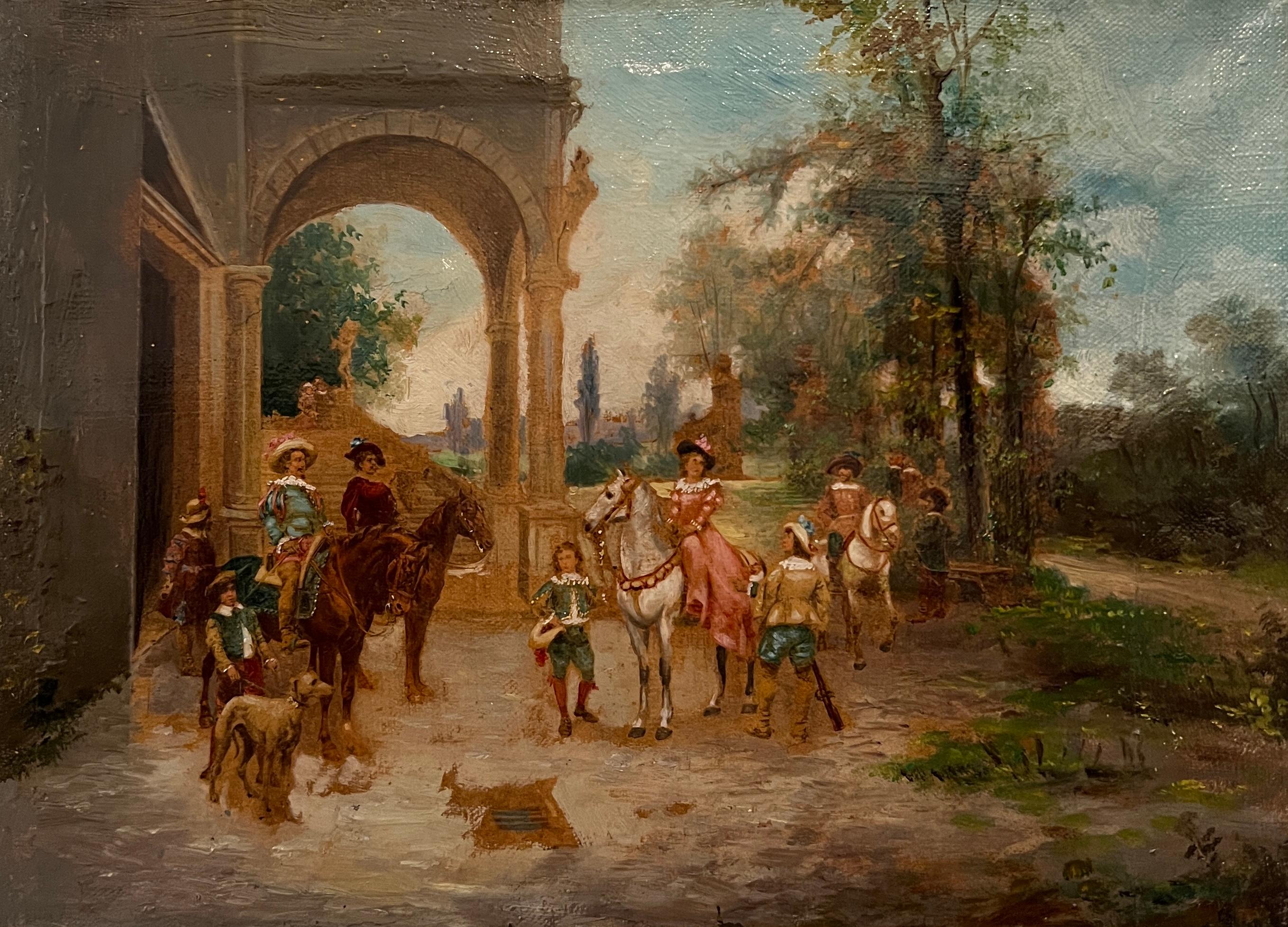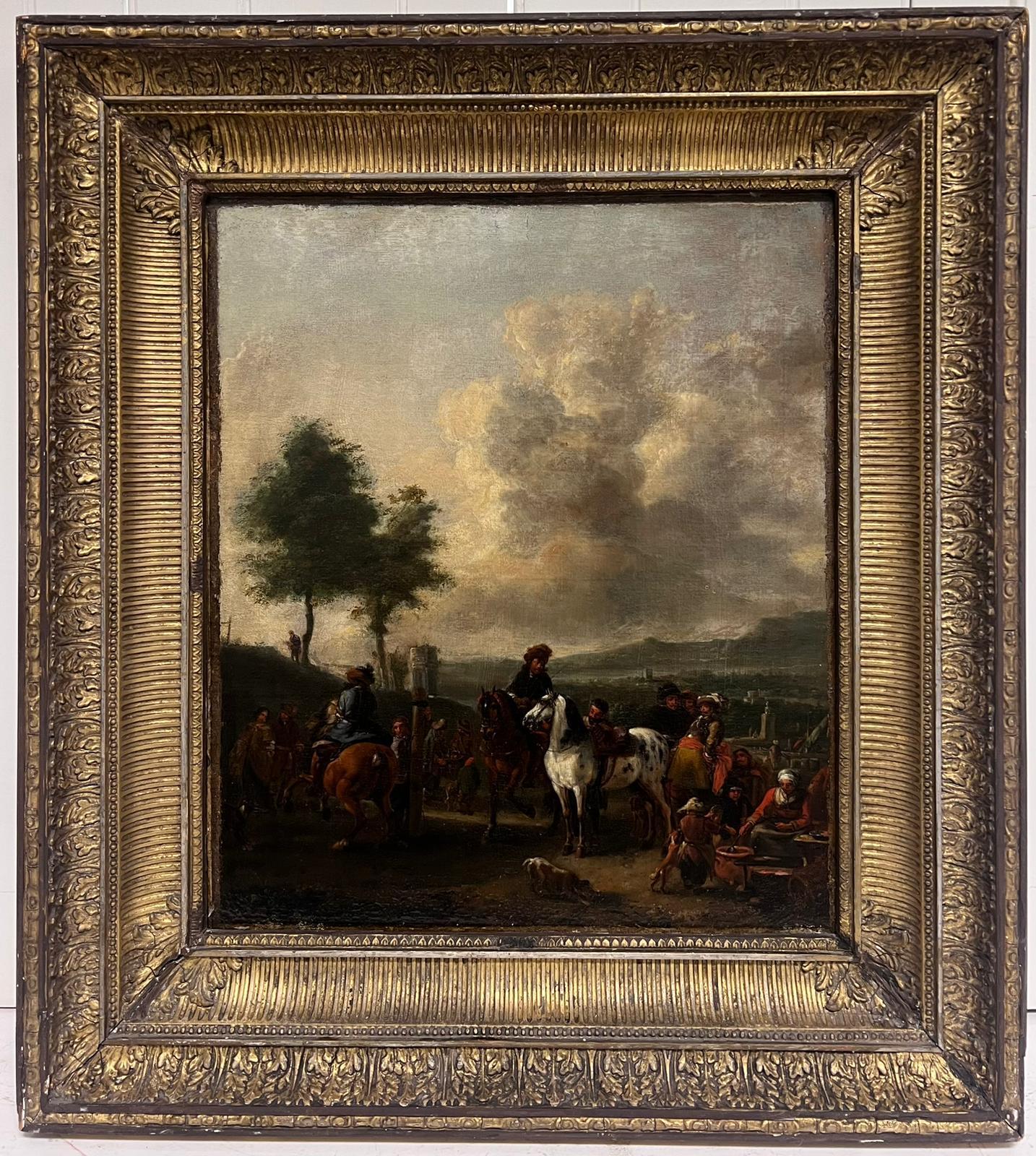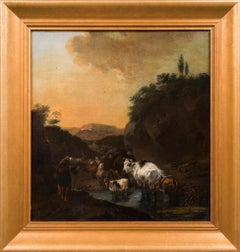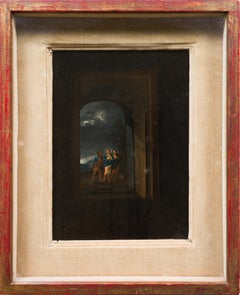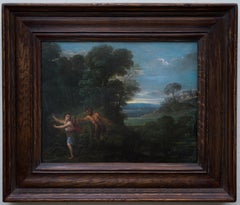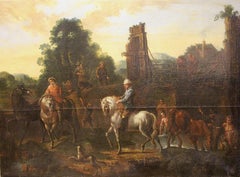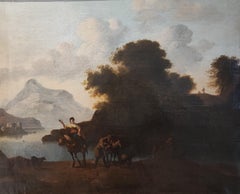Items Similar to Landscape with Gentleman on Horseback and Peasant Woman Receiving Alms
Want more images or videos?
Request additional images or videos from the seller
1 of 8
Landscape with Gentleman on Horseback and Peasant Woman Receiving Alms1600s
1600s
$18,054.70
£13,134.59
€15,000
CA$24,639.48
A$27,438.28
CHF 14,280.11
MX$338,310.68
NOK 181,868.10
SEK 170,938.39
DKK 114,156.98
Shipping
Retrieving quote...The 1stDibs Promise:
Authenticity Guarantee,
Money-Back Guarantee,
24-Hour Cancellation
About the Item
Workshop / Circle of Philips Wouwerman (1619-1668)
Landscape with Gentleman on Horseback and Peasant Woman Receiving Alms
oil on oak panel
12.40 x 14.17 inches (31.5 x 36 cm)
with frame 18.50 x 20.86 inches (47 x 53 cm)
Expertise: We would like to express our gratitude to Dr. Birgit Schumacher for her important research on this painting based on digital images.
Provenance:
Christie's sale 563 DL (stencil on the back);
Ernst Muzeum Sale no 658 (Museum located in Budapest);
Bukowskis Auctions, 1 June 2006, lot 1303, (sold as by Philips Wouwerman), sold for 26.460€ (including buyers premium)
Condition:
Recently restored by our art conservator in Stockholm.
The colors are bright and clear and the panel is flat and stable.
"It is a fine work in good condition" (BS).
Essay:
This painting that we are selling is a beautiful work of art from the inner circle of Philips Wouwerman (1619-1668), who is widely regarded as one of the most talented horse painters in the history of art. The painting is titled "Landscape with Gentleman on Horseback and Peasant Woman Receiving Alms".
In the background, we see a heavily loaded pack donkey and a resting man with heavy luggage. A dog is also present, adding to the lively and dynamic atmosphere of the painting.
The artwork exudes a sense of calm and serenity, capturing a moment of kindness and generosity between two individuals from different social classes. The composition is carefully balanced, with each element placed in a harmonious relationship with the others. The painting has been examined by Dr. Birgit Schumacher, an expert on Philips Wouwerman, who has confirmed that it is of high quality and painted in the 17th century in his Workshop or inner Circle. The painting follows one of his autograph works, with the same motif, who is catalogued as A379 in her Catalogue Raisonné.
Philips Wouwerman was a Dutch Golden Age painter known for his remarkable skill in depicting horses, landscapes, and hunting scenes. He was born in Haarlem, the son of a painter, and started his artistic career in his father's studio. Wouwerman's work gained popularity during his lifetime, and he was highly sought after by collectors and patrons from across Europe. His paintings are characterized by their exquisite attention to detail, vibrant colors, and skillful handling of light and shadow.
- Creation Year:1600s
- Dimensions:Height: 12.41 in (31.5 cm)Width: 14.18 in (36 cm)
- Medium:
- Movement & Style:
- Circle Of:Philips Wouwerman (1619 - 1668, Dutch)
- Period:
- Condition:Recently restored by our art conservator in Stockholm. The colors are bright and clear and the panel is flat and stable. "It is a fine work in good condition" (BS).
- Gallery Location:Stockholm, SE
- Reference Number:1stDibs: LU1445212170862
About the Seller
5.0
Platinum Seller
Premium sellers with a 4.7+ rating and 24-hour response times
Established in 2020
1stDibs seller since 2020
185 sales on 1stDibs
Typical response time: <1 hour
Associations
International Confederation of Art and Antique Dealers' Associations
- ShippingRetrieving quote...Shipping from: Stockholm, Sweden
- Return Policy
Authenticity Guarantee
In the unlikely event there’s an issue with an item’s authenticity, contact us within 1 year for a full refund. DetailsMoney-Back Guarantee
If your item is not as described, is damaged in transit, or does not arrive, contact us within 7 days for a full refund. Details24-Hour Cancellation
You have a 24-hour grace period in which to reconsider your purchase, with no questions asked.Vetted Professional Sellers
Our world-class sellers must adhere to strict standards for service and quality, maintaining the integrity of our listings.Price-Match Guarantee
If you find that a seller listed the same item for a lower price elsewhere, we’ll match it.Trusted Global Delivery
Our best-in-class carrier network provides specialized shipping options worldwide, including custom delivery.More From This Seller
View AllShepherd with Sheep, Cows and a Goat in a Landscape by Jan Frans Soolmaker
Located in Stockholm, SE
Jan Frans Soolmaker (Flanders 1635‑1685)
Shepherd with Sheep, Cows and a Goat in a Landscape
oil on relined canvas
canvas size 56 x 53 cm
frame i...
Category
17th Century Old Masters Animal Paintings
Materials
Canvas, Oil
$5,867 Sale Price
25% Off
Free Shipping
Shepherd with Sheep, Cows and a Goat in a Landscape by Jan Frans Soolmaker
Located in Stockholm, SE
This painting depicts a pastoral scene that is attributed to the artist Jan Frans Soolmaker, an artist known for his Italianate landscapes and scenes that often feature equestrian and Arcadian elements. The painting is not signed but is attributed to Soolmaker, relating it to a known signed work by the artist that was sold at Sotheby’s London in 1999.
The scene is suffused with the warm glow of a setting or rising sun, casting a soft light that is characteristic of Soolmaker’s landscapes. It shows a shepherd guiding a group of cattle across a shallow stream, with the animals taking center stage in the composition. The animals are rendered with careful attention to their forms and the play of light on their bodies, which is a hallmark of Soolmaker's work. The landscape is composed of a rocky terrain with trees and shrubbery, creating a sense of depth and natural beauty that invites the viewer to explore the scene further.
The background suggests a vast, open landscape with distant mountains, which adds to the Italianate feel of the painting. The sky is dramatic, with clouds catching the light of the sun, contributing to the overall serene yet dynamic atmosphere of the work.
The provenance of the painting is notable, having been in the possession of significant historical figures such as Swedish Prince Fredrik Adolf, and later The collection of Pär Ulmgren, The collection of Gösta Stenman, and Engineer and politician Gustaf Henry Hansson.
Potential buyers have the option of choosing between a newly made gold frame or an older brown frame, which allows for personalization in how the work is presented.
Soolmaker’s work is often compared to that of Dutch painter Nicolaes Berchem, whose style he emulated. Soolmaker's landscapes reflect a similar sensitivity to light and composition, making his works sought after for their beauty and historical significance. Despite the smaller body of work left by Soolmaker, due to his short career, his paintings are valued for their craftsmanship and the legacy of the artist’s brief but impactful contribution to the Dutch Italianate landscape genre.
Information:
Jan Frans Soolmaker (Flanders 1635‑1685)
Shepherd with Sheep...
Category
17th Century Old Masters Animal Paintings
Materials
Canvas, Oil
$4,333 Sale Price
20% Off
The Road to Emmaus, German Old Master Painting
Located in Stockholm, SE
German School, 1700s
The Road to Emmaus
oil on panel
unframed: 24.3 x 17.5 cm (9.6 x 6.9 inches)
framed: 34.5 x 28 cm (13.6 x 11 inches)
Provenance:
Swedish author and artist Amel...
Category
18th Century Old Masters Figurative Paintings
Materials
Oil, Wood Panel
Landscape With Pan and Syrinx, Flemish School From the 1600s, Oil on Copper
Located in Stockholm, SE
Flemish School, 1600s
Landscape With Pan and Syrinx
painted around the 1600s
oil on copper
19 x 23.5 cm
frame 29 x 34 cm
Hand-made oak frame by Swedish frame maker Christer Björkma...
Category
17th Century Old Masters Landscape Paintings
Materials
Copper
Peasants in a Cornfield (Boer in het veld) by David Teniers the Younger
By David Teniers the Younger
Located in Stockholm, SE
Remembering the magic of everyday life moments in the art of David Teniers:
The art of David Teniers the Younger (1610–1690) coincided with the heyday of the Flemish Baroque and captured a great variety of motifs of his time. In this painting of a seemingly simple peasant scene lies keys to understanding both the imaginative mind of Teniers as well as why this time period produced some of the most iconic works in all of art history.
As indicated by the name, Teniers was more or less born into his profession. As the son of David Teniers the elder, himself a painter who studied under Rubens, the younger David received training in art from a very young age and had no less than three brothers who also became painters. Because of his father’s frequent financial failures that even at times saw him imprisoned, David the younger helped to rescue the family from ruin through painting copies of old masters. Essentially, the young Teniers was confronted with painting as both a passion and creative expression as well as a necessity during difficult times, an experience that would shape much of his capacity and sensitivity in his coming life.
Despite the hardships, the talent and determination of Teniers was recognized and quickly expanded his possibilities. He had already spent time in France and possibly also England when he was hired by his father’s former teacher Rubens to help with a prestigious commission with mythological paintings, now considered lost, for Philip IV the king Spain. In 1644–54 Teniers was appointed dean of the Antwerp Guild of Saint Luke, manifesting his esteemed position within the artistic community. A few years afterwards he took an important step when relocating to Brussels, where Teniers yet again found new career opportunities that would prove to be very successful.
As the keeper of the collections of Archduke Leopold Wilhelm, a role similar to what we now refer to as an art advisor, Teniers purchased hundreds of important artworks that manifested the prominent status of the Archduke’s collection while at the same time providing an unusual access to inspiration and knowledge for Teniers himself. Since he kept on painting during the same time, his creative scope must have seemed almost bewildering in the great variety of images and stories that he surrounded himself with.
Regardless of how glamorous and culturally stimulating the career of Teniers was, he was as open to the charm and existential importance of everyday life as he was to works of great masters and luxurious collectibles. In his impressive repertoire of genres with everything from exquisite royal portraits, interiors, landscapes and history paintings he always added something new and inventive, highlighting the possibilities of art and importance of an experimental and intuitive mind. It is difficult to single out one aspect or genre to summarize his legacy, since it lies much more in the broad virtuosity across many motifs, although he is particularly remembered for farm scenes and meticulously depicted interiors where other paintings and artworks are captured with an astonishing precision. However, the fact that he is still today one of the most known and celebrated names of the Dutch Golden Age is a proof to the magic of his work, which continues to spark dialogue and wonder in the contemporary viewer of his works.
The farm boy in the field in this painting, which likely dates to the mature part of his career, is a wonderful entry into the mind of Teniers. In the tightly cropped motif, we see him standing right in the middle of the busy harvest when men, women and everyone capable were sent out in the field to collect the crop that formed the very core of their diet and survival. In the background we see a fresh blue sky interspersed with skillfully painted clouds, some trees reaching their autumnal colours and in the far distance the glimpse of a small church and village. The presence of a church in a landscape, so typical of Dutch art, served both a symbolic and visual function as a representation of faith while at the same time defining scale and distance.
In the field, the work is in full action with the farmers spread out in various positions, all in the midst of hard and sweaty labour. While they are portrayed as having nothing else than the work on their mind, our farm boy seems to have his attention directed elsewhere. Standing there with his white, half open shirt, flowy curls and strong, sturdy body; his gaze is directed away, out of the picture and the scythes in his hands. He looks almost smirking, expressed with tremendous subtlety in the slight smile of his lips and big eyes, being just in the middle of losing focus on the work. What is it that steals his attention? What has he seen, or realized, or felt – to break him free of the arduous task of harvesting, if but for a moment?
Here starts the wondering and the questions that are the hallmark of a great piece of art. Instead of explicitly locking in the motif in overly clear symbolism Teniers has chosen an open ended, subtle yet striking moment for us to consider. While it of course can be related to numerous other farm scene depictions of this time, and clever usages of gazes and real-life scenes to underscore various moral or symbolic meanings, the painting can be much more of a contemplation than an explanation or illustration. The ordinary nature and understated yet emotionally textured composition of the motif gives greater space for our own reactions and thoughts. Has he seen a pretty farm girl just passing by? Is he fed up with the farm life, joyously dreaming away for a minute, imagining another future? Or is he simply in need of distraction, looking away and ready for anything that can steal his attention?
One quality that never seem to have escaped Teniers was that of curiosity. During all of his career he constantly investigated, expanded and experimented with not only the style and technique of painting, but with the vision of art itself. Being credited with more or less introducing farm motifs for a broader audience not only tells us of his ability to understand the demand for different motifs, but the sensitivity to transform seemingly ordinary parts of life into deep aesthetic experiences, far beyond their expected reach. The farm boy in this painting is, of course, exactly that. But with the help of one smirk the entire picture is charged with a different energy, awakening many contrasts and relationships between the calm landscape, the hard work and his own breach of effectivity, holding sharp scythes while thinking or seeing something else.
It is no wonder Teniers chose to work with farm scenes as a way of investigating these intricate and delicate plays on expectations and surprises, clarity and ambivalence. It invites us to an appreciation of human everyday life that connects us with the people of 17th century...
Category
Late 17th Century Old Masters Landscape Paintings
Materials
Canvas, Oil
A Small Old Painting Called Rocky Path With Figures
By Thomas Barker of Bath
Located in Stockholm, SE
This exquisite painting, titled "Rocky Path With Figures" is a captivating example of Thomas Barker of Bath's talent. Despite its small size, measuring only 13 x 11 cm, this piece sh...
Category
Early 19th Century Figurative Paintings
Materials
Oil, Panel
$3,273 Sale Price
20% Off
You May Also Like
17th Century, Old Master Painting, Oil on Canvas, "The Rest with the Horses".
Located in Berlin, DE
17th century, old master painting, oil on canvas, "The rest with the horses".
Relined canvas.
The stretcher was also renewed once.
The painting is rather dark, like i.a. on photo n...
Category
17th Century Old Masters Figurative Paintings
Materials
Canvas, Oil
$17,332 Sale Price
50% Off
Free Shipping
Travellers and Carriage in Landscape Dutch 17th century Golden Age oil painting
Located in London, GB
This superb Dutch Old Master Golden Age oil painting is attributed to Pieter Bodding van Laer. Painted circa 1635 the composition is a group of travellers who have stopped to rest. I...
Category
17th Century Old Masters Landscape Paintings
Materials
Oil
$13,460 Sale Price
20% Off
Animated landscape, a stopover for travelers on horseback
Located in Genève, GE
Work on canvas
Plaster and gilded wood frame
89.5 x 105 x 7 cm
Category
Late 18th Century Italian School Landscape Paintings
Materials
Oil
Van der Bent, Southern Landscape with woman animals, Dutch Old Master, Berchem
Located in Greven, DE
17th Century Old Master, Figurative and Landscape Painting by Jan Van der Bent
So far, little is known about the life and work of Jan van der Bent. He was...
Category
17th Century Baroque Landscape Paintings
Materials
Canvas, Oil
$17,813 Sale Price
20% Off
Landscape with riders and figures
Located in Genève, GE
Work on canvas
Category
19th Century Landscape Paintings
Materials
Oil
Fine 17th Century Dutch Old Master Oil Military Encampment Figures on Horseback
By Philips Wouwerman
Located in Cirencester, Gloucestershire
The Military Encampment
Dutch School, 17th century
circle of Philips Wouwermans (Dutch 1619-1668)
oil painting on canvas, in 18th century gilt frame
canvas measures: 19.5 x 17 inches...
Category
17th Century Old Masters Landscape Paintings
Materials
Oil, Canvas
$3,876 Sale Price
30% Off
